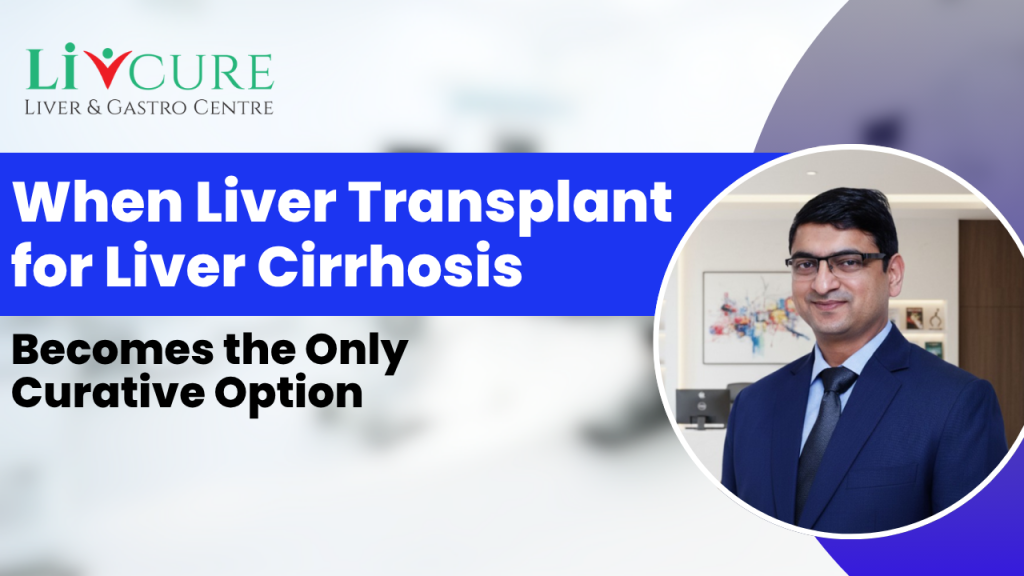
When I meet patients diagnosed with liver cirrhosis, I often sense two emotions in the room — fear and confusion. They’ve heard the word “cirrhosis,” but very few understand what it truly means. Many ask me, “Doctor, can this be cured with medicine?” or “Is there any other option besides a transplant?”
The truth is — in its early stages, cirrhosis can be managed, sometimes even slowed down. But once the liver reaches a point of irreversible damage, a liver transplant for liver cirrhosis becomes the only curative option.
In this article, I want to explain — in simple language — what liver cirrhosis actually is, how it progresses, when it becomes life-threatening, and how a liver transplant can offer a new chance at life.
Understanding Liver Cirrhosis
Your liver is a remarkable organ — it filters toxins, regulates hormones, stores energy, and processes nutrients. But when it faces chronic injury for years, the healthy tissue gradually gets replaced by scar tissue. This condition is called cirrhosis.
In the beginning, the liver tries to heal itself. But over time, excessive scarring distorts its structure and blocks blood flow. Eventually, the organ loses its ability to perform vital functions a state known as end-stage liver disease.
Common Causes of Liver Cirrhosis
- Chronic Hepatitis B or C infection – long-term viral inflammation damages liver cells.
- Alcohol-related liver disease – continuous alcohol exposure leads to fat accumulation and scarring.
- Non-alcoholic fatty liver disease (NAFLD) – increasingly common due to obesity and diabetes.
- Autoimmune hepatitis – the immune system mistakenly attacks liver cells.
- Genetic or metabolic disorders – such as Wilson’s disease or hemochromatosis.
- Biliary diseases – chronic blockage or inflammation of the bile ducts.
Regardless of the cause, the outcome is the same — progressive fibrosis that eventually destroys normal liver architecture.
The Stages of Liver Cirrhosis
Cirrhosis doesn’t appear overnight. It develops slowly over the years, often silently. I explain it to patients as a journey with three major phases:
1. Compensated Cirrhosis
At this stage, the liver is scarred but still performing most of its functions. Many people have no noticeable symptoms. Some might feel mild fatigue or abdominal discomfort, but overall, life continues normally.
With lifestyle changes, abstaining from alcohol, treating viral infections, and controlling weight, the disease can stay stable for many years.
2. Decompensated Cirrhosis
This is when the liver can no longer keep up. The patient begins to experience visible complications such as:
- Jaundice (yellowing of eyes and skin)
- Ascites (fluid buildup in the abdomen)
- Oedema (swelling of legs)
- Variceal bleeding (vomiting blood or black stools)
- Hepatic encephalopathy (confusion, forgetfulness, drowsiness)
Decompensated cirrhosis means the liver has reached the threshold of failure. Medications can only manage symptoms — they can’t reverse the damage.
3. End-Stage Liver Disease (ESLD)
When the liver completely loses function, the situation becomes critical. This is the point where a liver transplant for liver cirrhosis becomes the only definitive treatment that can actually replace the damaged organ and restore life.
Why Liver Transplant Is the Only Curative Treatment?
Patients often ask, “Can’t medicines regenerate my liver?” Unfortunately, when cirrhosis is advanced, the natural healing capacity of the liver is lost. Medications, lifestyle, or home remedies cannot reverse scarring.
A liver transplant is unique because it doesn’t merely support the failing organ — it replaces it entirely. By transplanting a healthy donor liver (or part of one, in living-donor transplants), we give the body a new functional organ capable of performing every necessary task again.
In simple terms:
- Medicines control complications.
- Procedures buy time.
- But only a liver transplant cures the underlying problem.
That’s why for patients with end-stage cirrhosis, transplant becomes the last stop — and the only way forward.
How Do Doctors Determine When It’s Time for a Transplant?
Not every patient with cirrhosis needs a transplant immediately. Deciding the right time is critical. We assess the severity using internationally accepted scoring systems such as MELD (Model for End-Stage Liver Disease) and Child–Pugh score.
Key Indicators That Suggest Transplant Evaluation:
- Recurrent fluid accumulation despite medication
- Repeated hospitalisations for bleeding or encephalopathy
- Persistent jaundice or itching
- Worsening blood test results (high bilirubin, INR, low albumin)
- Progressive fatigue and weight loss
Once a patient’s MELD score crosses a certain threshold, transplant evaluation begins. The goal is to perform the transplant before irreversible complications like kidney failure or sepsis set in.
Timing is everything — waiting too long can increase risk, but acting early can save life and improve post-surgery outcomes.
The Transplant Process, Step by Step
1. Evaluation and Preparation
We conduct a comprehensive evaluation covering blood tests, heart and lung assessments, and infection screening. This ensures the patient can safely undergo surgery.
2. Donor Identification
There are two types of transplants:
- Deceased-donor transplant – the liver comes from a brain-dead donor whose family consents to donation.
- Living-donor transplant – a healthy family member donates a portion of their liver (which regenerates to normal size within weeks).
In India, living-donor transplants are more common due to limited deceased donations.
3. Surgery
During surgery, the diseased liver is removed and replaced with the donor’s liver or its portion. The operation usually lasts 8–12 hours and involves high-precision teamwork among surgeons, anaesthetists, and nurses.
4. Recovery
Patients typically spend a few days in the ICU followed by 2–3 weeks in the hospital. Within a month, most resume oral diet, light activity, and normal conversations.
5. Lifelong Care
After discharge, immunosuppressant medications are prescribed to prevent rejection. Regular check-ups, blood tests, and imaging ensure everything remains stable. With discipline, many patients return to a completely normal lifestyle.
Success Rate and Survival After Transplant
Modern liver transplantation has achieved remarkable success rates.
- One-year survival: 85–90 %
- Five-year survival: around 78–80 %
- Ten-year survival: 75 – 77% or higher in compliant patients
For those battling end-stage cirrhosis, these numbers represent hope — a chance not only to live but to live well.
Post-transplant, patients often report renewed energy, mental clarity, and freedom from the distressing symptoms that once dominated their lives.
Common Concerns and Misconceptions
- Is transplant risky?
Any major surgery has risks, but with experienced teams and advanced monitoring, success rates are excellent. The risks of not doing a transplant in end-stage cirrhosis are far greater than proceeding with one.
- Will I need medicines forever?
Yes, but they are well-tolerated by most people. Immunosuppressants prevent rejection and are the key to long-term success.
- Can my lifestyle return to normal?
Absolutely. Once recovery stabilises, patients can work, travel, and enjoy family life. Alcohol, however, must be avoided permanently.
- What about donors — is it safe for them?
In living-donor surgery, we remove only a portion of the liver. The donor’s remaining liver regenerates completely in 6–8 weeks. With proper selection, donor safety is extremely high.
The Emotional Journey for Patients and Families
Liver cirrhosis doesn’t affect the patient alone — it impacts the entire family. The uncertainty, fear, and financial burden can feel overwhelming. As a doctor, I always emphasise open communication and emotional preparation.
Families should ask questions, understand each step, and stay involved in post-transplant care. In India, where family bonds are strong, such involvement greatly improves compliance and recovery.
Support groups, counselling, and faith also play a big role in helping patients adapt to life after transplant.
Life After Liver Transplant for Liver Cirrhosis
The first few months after transplant are about healing and building confidence. Patients notice dramatic changes:
- Appetite and digestion improve.
- Jaundice and swelling disappear.
- Fatigue is replaced with energy.
- Mental clarity returns.
In the long run, success depends on maintaining a healthy routine — a balanced diet, regular exercise, a strict medication schedule, and follow-ups.
With consistent care, the average life after a liver transplant for cirrhosis can easily span two decades or more. Many of the patients have gone back to work, travelled abroad, and led completely normal lives for years.
Preventing Cirrhosis Progression — Early Steps Matter
While a transplant is the final cure, prevention remains the best strategy. If you’ve been diagnosed with early-stage liver disease, act immediately:
- Avoid alcohol completely.
- Treat viral hepatitis with antiviral medicines.
- Maintain a healthy weight to prevent fatty liver.
- Control diabetes and cholesterol.
- Get vaccinated for hepatitis A and B.
- Have regular liver check-ups (ultrasound, LFTs).
Taking these steps early can prevent the need for a transplant altogether.
Key Takeaways: The Last Stop, But Not the End
- Liver cirrhosis is the final pathway of chronic liver injury.
- In advanced stages, medical therapy cannot reverse the damage.
- Liver transplant for liver cirrhosis is the only curative option when the liver fails.
- With modern techniques, success and survival rates are excellent.
- Early evaluation and timely surgery save lives.
A transplant is not a defeat, it’s a second chance. For patients with end-stage liver disease, it represents a doorway back to health, family, and future.
The Journey Ahead
When I look at patients months after their transplants walking unaided, smiling, planning vacations, it reaffirms why we call this procedure “life-giving.”
If you or a loved one has been told that the liver is failing, don’t lose hope. Consult an experienced liver transplant team early. The earlier we evaluate, the better the chances of success.Remember, the last stop doesn’t mean the end, it’s the beginning of a new, healthier chapter.
